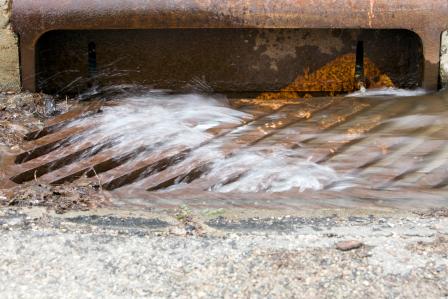Sources of Beach Pollution

- Wet Weather Discharges
Wet weather discharges are end-of-pipe discharges resulting from precipitation, such as rainfall and snowmelt. They include storm water runoff, combined sewer overflows (CSOs), and wet weather sanitary sewer overflows (SSOs). Storm water runoff accumulates pollutants such as oil and grease, chemicals, nutrients, metals, and bacteria as it travels across land. CSOs and wet weather SSOs contain a mixture of raw sewage, industrial wastewater and storm water, and have resulted in beach closings, shellfish bed closings, and aesthetic problems.- Stormwater
When rain water or snowmelt flows over land or impervious surfaces like paved streets, parking lots, and building roof-tops, it picks up trash, chemicals, sediment, and other pollutants such as gasoline, motor oil, antifreeze, fertilizers, pesticides and pet waste). This polluted water flows directly into storm drains, rivers, lakes, streams and the ocean. - Combined Sewer Overflows
Some sewers are designed to collect rainwater runoff, domestic sewage, and industrial wastewater in the same pipe, and are known as combined sewers. Most of the time, combined sewer systems transport all of their wastewater to a sewage treatment plant, where it is treated and then discharged to a water body. During periods of heavy rainfall or snowmelt, however, the wastewater volume in a combined sewer system can exceed the capacity of the sewer system or treatment plant. For this reason, combined sewer systems are designed to overflow occasionally and discharge excess wastewater directly to nearby streams, rivers, or other water bodies. - Sanitary Sewer Overflows
Sanitary sewer systems are designed to collect and transport all sewage that flows into them to a publicly owned treatment works (POTW). However, occasional unintentional discharges of raw sewage from municipal sanitary sewers occur in almost every system. These types of discharges are called sanitary sewer overflows (SSOs). SSOs have a variety of causes, including but not limited to blockages, line breaks, sewer defects that allow storm water and groundwater to overload the system, lapses in sewer system operation and maintenance, power failures, inadequate sewer design and vandalism.
- Stormwater
- Trash and Litter
Trash and other solid material that reach rivers, bays, estuaries and oceans eventually wash up on our beaches. It includes plastic bags, bottles and cans, cigarette filters, bottle caps, and lids. Any trash not recycled or properly thrown away can eventually reach our beaches when it is carried by the rain into sewers, storm drains, or inland rivers and streams, and then can flow all the way to the ocean. Other sources include people at the beach leaving behind their trash, and fishermen losing or discarding fishing nets and lines in the ocean.
- Vessel Discharges
Incidental discharges from all kinds of vessels are a source of pollution that can affect our beaches. Such discharges include trash, fishing gear, ballast water, and water from sinks and showers. The way EPA controls these discharges depends on the type of vessel: recreational vessels are covered under the Clean Boating Act, and commercial vessels are covered under the National Pollutant Discharge Elimination System (NPDES) permit program.- Discharges from Recreational Vessels (Covered by Cleaning Boating Act) A recreational vessel is manufactured or used primarily for pleasure. This includes canoes, kayaks, motor boats, yachts and sailboats. Ships and recreational boats at sea sometimes intentionally or accidentally dump trash directly into the ocean. This trash can include food containers and fishing gear like nets, ropes, and light sticks. The Clean Boating Act is an amendment of the Clean Water Act (CWA) that requires EPA to develop management practices to help limit the amount of pollution discharged from recreational vessels into our nation's waters.
- Discharges from Commercial Vessels (Covered by EPA Permit Program)
There are different requirements to control discharges from commercial vessels, including those used to transport paying passengers. EPA currently regulates incidental discharges from the normal operation of non-recreational vessels with the Vessel General Permit (VGP). Such discharges include ballast water, bilgewater, graywater (e.g., water from sinks, showers), and anti-foulant paints.
- Nitrogen and Phosphorus (Nutrients)
One of America’s most widespread and costly problems is excess nitrogen and phosphorus in the air and water. Nitrogen and phosphorus are nutrients that are natural parts of aquatic ecosystems. These elements support the growth of algae and aquatic plants, which provide food and habitat for fish, shellfish and smaller organisms that live in water. But when too much nitrogen and phosphorus enter the environment — usually from a wide range of human activities — the air and water can become polluted, resulting in serious environmental and human health issues, and impacting the economy. Animal manure, excess fertilizer applied to crops and fields, and soil erosion make agriculture one of the largest sources of nitrogen and phosphorus pollution in the country. Other sources include stormwater, wastewater, fossil fuels, fertilizers for home use, and yard and pet waste.


